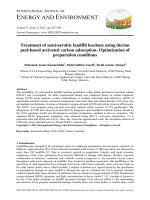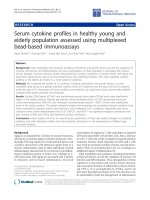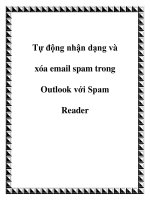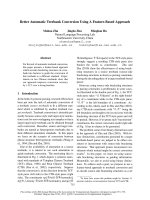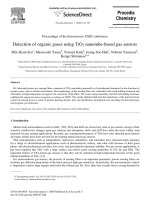Email spam filtering using R-chunk detector based negative selection algorithm
Bạn đang xem bản rút gọn của tài liệu. Xem và tải ngay bản đầy đủ của tài liệu tại đây (569.15 KB, 5 trang )
Vũ Đức Quang và Đtg
Tạp chí KHOA HỌC & CÔNG NGHỆ
135(05): 185 - 189
EMAIL SPAM FILTERING USING R-CHUNK DETECTOR-BASED NEGATIVE
SELECTION ALGORITHM
Vu Duc Quang1*, Vu Manh Xuan1,
Nguyen Van Truong1, Phung Thi Thu Trang2
1
College of Education–TNU, 2Foreign Language Faculty- TNU
SUMMARY
Email spam is one of the biggest challenges when using the Internet today. It causes a lot of
troubles to users and does indirect damages to the economy. Machine learning is a keyapproach
for spam filtering. Artificial Immune System (AIS) is a diverse research area that combines the
disciplines of immunology and computation.Negative selection mechanism is one of the most
studied models of biology immune system for anomaly detection. In this paper, Negative Selection
Algorithms (NSA), a computational imitation of negative selection, ismodeledfor spam filtering.
The experimental results on popular TREC’07 spam corpus show that our approach is an effective
solution to the problem on both time complexities and classification performance.
Keywords: Artificial immune system, negative selection algorithm, spam filtering, r-chunk
detector
INTRODUCTION*
Email is one of the most popular means of
communication nowadays. There are billions
of emails sent every day in the world, half of
which are spams. Spams are unexpected
emails for most users that aresent in bulk with
main purpose of advertising, stealing
information, spreading viruses.For example,
Trojan.Win32.Yakes.fize
is
the
most
malicious attachment Trojan that downloads a
malicious file on the victim computer, runs it,
steals the user's personal information and
forwards it to the fraudsters.
There are a lot of spam filtering methods such
as Blacklisting, Whitelisting, Heuristic
filtering,
Challenge/Response
Filter,
Throttling,
Address
obfuscation,
Collaborative filtering. However, most of
anti-spam filters base on the headers of letters
or the sending address to increase the speed.
One uses complicated techniques to improve
accuracy affects the speed of the whole
system as well as the psychology of users.
Recently, machine learning approaches have
been paid more attention because they are
highly adaptable to the spam digestion, such
as Naïve Bayes, Support Vector Machine, K*
Tel: 01652 340851; Email:
Nearest Neighborsand
Network.
Artificial
Neuron
AIS inspired by lymphocyte repertoires
includes negative and positive selection,
clonal selection, and B cell algorithms.
Among various mechanisms in the immune
system that are explored for AIS, negative
selection is one of the most studied models.
NSA is a computational imitation of selfnonself discrimination, it is first designed as a
change detection method. Since its
introduction in 1994, NSA has been a source
of inspiration for many computing
applications,
especially
for
intrusion
detection, computer virus detection and
monitoring UNIX processes [8].
The outline of a typical NSA contains two
stages [1]. In the generation (or training) stage
(Fig. 1), the detectors are generated by some
random processes and censored by trying to
match given self samples taken from set S.
Those candidates that match are eliminated
and the rest are kept as detectors in set D. In
the detection (or testing, classifying) stage,
the collection of detectors (or detectors set) is
used to verify whether an incoming data
instance is self or nonself. If it matches any
detector, it is claimed as nonself or anomaly,
otherwise it is self.
185
Nitro PDF Software
100 Portable Document Lane
Wonderland
Vũ Đức Quang và Đtg
Tạp chí KHOA HỌC & CÔNG NGHỆ
The r-chunk and r-contiguous detectors are
considered the most common ones in the AIS
literature. The r-contiguous detectors are
originally researched by many authors, and rchunk detectors were later introduced to
achieve better results on data where adjacent
regions of the input strings are not necessarily
and semantically correlated, such as network
data packets. In this article, we only apply
NSA under r-chunk detectors to solve the
problem of spam filtering.
Begin
Generate random
candidates
Match self samples?
Yes
No
Accept as new detector
Enough detectors?
No
Yes
End
Figure 1. Model of negative detector generation
All existing NSAs for spam filtering use
modified version of the classical one with
real-valued vector representation for data and
detectors. They are always combined with
text mining algorithms. Our contribution is to
apply an r-chunk detector-based NSAthat
uses binary string representation to increase
effectiveness of the detection process and
reduce the runtime significantly.
The remaining of the paper is organized as
follows: In the next section, we define rchunk detectors. The subsequent section, the
main part of the paper, shows the r-chunk
detector-based NSA for spam filtering. In the
last section, we summarize our approach and
discuss future works.
BINARY CHUNK-BASED DETECTORS
In this paper, we consider NSA as a classifier
operating on a binary string space ℓ, where
135(05): 185 - 189
= {0, 1}. We also use the following notations:
Let s ℓ be a binary string. Then ℓ = |s| is
the length of s and s[i,…, j] is the substring of
s with length j – i + 1 that starts at position i.
In the following section, we will show how to
convert anarbitrary string to binary one.
Definition 1 (Chunk detectors). An r-chunk
detector (d, i) is a tuple of a string d r and
an integer i {1,…, ℓ - r + 1}. It matches
another string s ℓ if s[i,…, i + r - 1] = d.
Example 1. Given a self set S having 6 binary
strings, with ℓ = 5 and r = 3: S = {s1 = 00000;
s2 = 00010; s3 = 10110; s4 = 10111; s5 =
11000; s6 = 11010}, all 3-chunk detectors that
do not match any string in S are listed as
following:D = {(001,1); (010,1); (011,1);
(100,1); (111,1); (010,2); (110,2); (111,2);
(001,3); (011,3); (100,3); (101,3)}.
Each 3-chunk detector can detect a sub-set of
nonself strings. For example, detector (111,1)
can classify four strings 11100, 11101, 11110,
11111 as nonself strings or spams because
they all match string 111 at their first
position.
Using chunk detectors may reduce number of
undetectable strings, or holes, in comparison to
r-contiguous detectors based approaches [8].
NEGATIVE SELECTION ALGORITHM
FOR SPAM FILTERING
A two-dimensionalarrayused as a main data
structure in our studyis just for easy
understanding ouralgorithm. The readers can
refer to [4, 7] for more effective r-chunk
detectors generation on treesor automata. The
algorithm is divided into two phases:training
phase to generate detectors and testing one to
check whether a given string is ham (self) or
spam (nonself)as follows.
The training process
Input: A self set S of the binary strings
converted from hams with the same length of
ℓ; an integer r, 1 < r < ℓ.
Output: Set of r-chunk detectors D.
Firstly,a temporary array A with the size of 2r
× (ℓ-r+1) is used as a hash table of S. Then
detectors are created from the above array.
186
Nitro PDF Software
100 Portable Document Lane
Wonderland
Vũ Đức Quang và Đtg
Tạp chí KHOA HỌC & CÔNG NGHỆ
ProcedureChunk_Generation;
Begin
Create array Ahavingall elements are
assigned to 0;
Foreach s in S do
For j:=1 to ℓ-r+1 do
Begin
i := the integer number of binary substring of s whose length is r and
starting position is j within the string
s;
A[i, j] := 1;
End;
D = ;
For i:=0 to 2r do
For j:=1 to ℓ-r+1 do
If A[i,j]=0 then D := D (i2, j);
End;
For example, with s3 = 10110 as in Example
1, three elements A[5, 1], A[3, 2] and A[6, 3]
are assigned to 1. These then create three 3chunk detectors (101, 1), (011, 2) and (110,
3).
The testing process.
Input: Set of detectors D, a string s, and two
integer ℓ, r.
Output: Detection of s if it is spam or ham.
This process is easier than the first one.A
Boolean variable check_spamis used to check
if the given string s is spam or not.
ProcedureChunk_Detection;
Begin
check_spam:=false;
For j:=1 to ℓ-r+1 do
Begin
i := sub-string of s whose length is r
and starting position is j within the
string s;
If (i, j) in D then
Begin
check_spam:=true;
Break;
135(05): 185 - 189
End;
End;
Ifcheck_spamthen “s is spam” else “s is
ham”;
End;
The time complexities of the training process
and testing process are O(|S|.(ℓ-r+1)) and (ℓr+1), respectively.
EXPERIMENT
In this section, theexperiment on theTREC’07
spam corpus [6] is implemented and its
results are compared with those of most
recentones [3].
TREC’07 spam corpus stored 75.419 emails
including 50.199 spams and 25.220 hams.
That is one of the largest and most reputable
data co-sponsored by the National Institute of
Standards and Technology (NIST) and U.S.
Department of Defense.This Spam Corpus
is suitable for our research because of two
factors: Firstly, it is publicly available,
making it possible for new and old
researchers to verify the results or test
against the same corpus. Secondly, the
spam corpus is gathered from multiple
addresses
that provide
better
experimental results than when it is
collected from a single address.
Before performing binary-based NSA, we
remove the structure information of emails,
i.e. the header tags, to retain only the text
content, as seen in Fig. 2.
OEM software at greatest bargains!
Ms Office 2007, Windows Vista, Photoshop
all are below $50. Why waiting??
o
Figure 2. Typical text content of a spam email
from TREC’07 spam corpus
Then each email content is processed by
removing all punctuation marks and
spaces,then converted (each character’s
ASCII code) into the binary form. Naturally,
hams and spams are considered as self and
187
Nitro PDF Software
100 Portable Document Lane
Wonderland
Vũ Đức Quang và Đtg
Tạp chí KHOA HỌC & CÔNG NGHỆ
nonself, respectively. Therefore, only binary
strings that represent hams are used for the
training phase.
In 75.419 emails, we choose 5000 hams and
5000 spams randomly, then used 5000 hams
onlyfor training by Chunk_Generation
algorithm.
We used the common performance
measurements: TP (True positive: the number
of spam emails classified correctly), TN (True
negative: the number of ham emails classified
correctly), FP (False positive: the number of
ham inaccurately classified as spam) and FN
(False negative: The number of spam wrongly
classified as ham).
Other measurementslike Detection Rate (DR),
False positive rate (FPR) and Overall
accuracy (Acc) are listed as follows:
DR = TP/(TP + FN)
FPR = FP/(TN + FP)
Acc = (TP + TN) /(TP + TN + FP + FN)
Table 1. Nine-fold experiment on TREC’07
HAM SPAM TP FP FN TN DR FPR Acc
100
900
894 0 6 100 99.33
0
99.40
200
800
793 0 7 200 99.13
0
99.30
300
700
695 0 5 300 99.29
0
99.50
400
600
596 0 4 400 99.33
0
99.60
500
500
496 0 4 500 99.20
0
99.60
600
400
399 0 1 600 99.75
0
99.90
700
300
297 0 3 700
99
0
99.70
800
200
200 0 0 800 100
0
100
900
100
100 0 0 900 100
0
100
0
99.67
Average
99.45
135(05): 185 - 189
This results support our approach to the spam
filter using NSA under r-chunk detectors with
binary representation.
In
[3],
the
average
performance
measurements DR, FPR and Acc when
usingNSA are 51.5%, 0%, 76.44%, and when
using a combination of Naïve Bayesand
Clone Selection and NSA are 98.09%, 0%,
98.82%, respectively. These results are much
lower in comparison with our ones, the
corresponding measurementsshowed in the
Table 1, 99.45%, 0%, 99.67%.
The binary representation proposed in our
approach is main factor that lead to the good
results.The optimal argument ℓ, r also play an
important role in the algorithm. Moreover, in
terms of execution time, the their program
runs 9:31s on average, while our program to
train only takes 50s only (we use Visual C#
2013 as IDE on Windows 8.1 Pro, Chip Core
i5, 3210M, 2.5Ghz, RAM DDR3 2GB).
CONCLUSIONS
In this paper we performed content-based
spam filtering using NSA. The standard
benchmark spam corpusTREC’07 is used for
experiment with9-fold cross experiment
technique.The results show a much better
classification performance than most recent
results in [3]. We predict that better results
would be obtain if more techniques are used
in data preprocess, such as removing all stop
words, compressing data, and removing
words that appear in both hams and spams.
This expansion will be presented in detailed
in our next article.
We used 9 test cases: each test contains 1000
emails taken randomly from the original set
10000 emails and change corresponding
percentage between the number of hams and
spams as used in [3]. Two arguments ℓ, r are
assigned to 55 and 17, respectively. These
optimal arguments are chosen after several
runs of the algorithm. The results are showed
in Table 1.
In future works, we seek to extend the model
to other data representations and apply itto
awide range of spam types, such as Blog
spam, SMS spam and Web spam. Moreover,
combining immune algorithms with classical
statistical models maybe a very good idea for
the problem.
The experimental results shows a remarkable
performance with overall 99.67% accuracy.
1. Forrest et al, 1994, Self-Nonself Discrimination
in a Computer, in Proceedings of 1994 IEEE
REFERENCES
188
Nitro PDF Software
100 Portable Document Lane
Wonderland
Vũ Đức Quang và Đtg
Tạp chí KHOA HỌC & CÔNG NGHỆ
Symposium on Research in Security and Privacy,
Oakland, CA, 202-212.
2. Gordon Cormack, 2007, TREC 2007 Spam
Track Overview, University of Waterloo,
Waterloo, Ontario, Canada.
3. MarwaKhairy et al, 2014, An Efficient Threephase Email Spam Filtering Technique, British
Journal of Mathematics & Computer Science 4(9):
1184-1201.
4. Nguyen Van Truong, Vu Duc Quang, Trinh
Van Ha, 2012, A fast r-chunk detector-based
negative selection algorithm, Journal of Science
and Technology, Thai Nguyen University, 2 (90),
55-58.
5. Terri Oda, 2004, A Spam-Detecting Artificial
Immune System, Master thesis of Computer
135(05): 185 - 189
Science, Ottawa-Carleton Institute for Computer
Science School of Computer Science Carleton
University Ottawa, Canada.
6. T. Stibor et al., 2004, An investigation of rchunk detector generation on higher alphabets,
GECCO 2004, LNCS 3102, 299-307.
7. J. Textor, K. Dannenberg, and M. Liskiewicz,
2014, A generic finite automata based approach to
implementing lymphocyte repertoire models. In
Proceedings of the 2014 Conference on Genetic
and Evolutionary Computation, GECCO'14, 129136, USA.
8. Z. Ji and D. Dasgupta, 2007, Revisiting
negative selection algorithms. Evol. Comput.,
15(2):223-251.
TÓM TẮT
LỌC THƯ RÁC SỬ DỤNG THUẬT TOÁN CHỌN LỌC ÂM TÍNH
DỰA TRÊN BỘ DÒ R-CHUNK
Vũ Đức Quang1*, Vũ Mạnh Xuân1,
Nguyễn Văn Trường1, Phùng Thị Thu Trang2
1
Trường Đại học Sư phạm - ĐH Thái Nguyên,
2
Khoa Ngoại ngữ - ĐH Thái Nguyên
Hiện nay, thư rác là một trong những vấn đề đáng lo ngại khi sử dụng Internet. Nó gây nhiều phiền
toái cho người dùng và gián tiếp làm thiệt hại về kinh tế. Học máy là một cách tiếp cận chính cho
lọc thư rác. Hệ miễn dịch nhân tạo là một lĩnh vực nghiên cứu phong phú kết hợp các nguyên lý
miễn dịch học và tính toán. Cơ chế chọn lọc âm tính là một trong những mô hình được nghiên cứu
nhiều nhất của hệ thống miễn dịch sinh học cho phát hiện bất thường. Trong bài báo này, thuật
toán chọn lọc âm tính, một mô phỏng của chọn lọc âm tính trên máy tính, được mô hình cho bài
toán lọc thư rác. Kết quả thực nghiệm với bộ dữ liệu thư rác TREC’07 cho thấy đây là một phương
pháp hiệu quả để xử lí cho vấn đề này trên cả hai tiêu chí là độ phức tạp thời gian thực hiện và
hiệu suất phân loại.
Từ khóa: Hệ miễn dịch nhân tạo, thuật toán chọn lọc âm tính, lọc thư rác, bộ dò r-chunk
Ngày nhận bài:25/9/2015; Ngày phản biện:10/10/2015; Ngày duyệt đăng: 31/5/2015
Phản biện khoa học: PGS.TS Nguyễn Văn Tảo – Trường Đại học Công nghệ Thông tin & Truyền thông- ĐHTN
*
Tel: 01652 340851; Email:
189
Nitro PDF Software
100 Portable Document Lane
Wonderland
